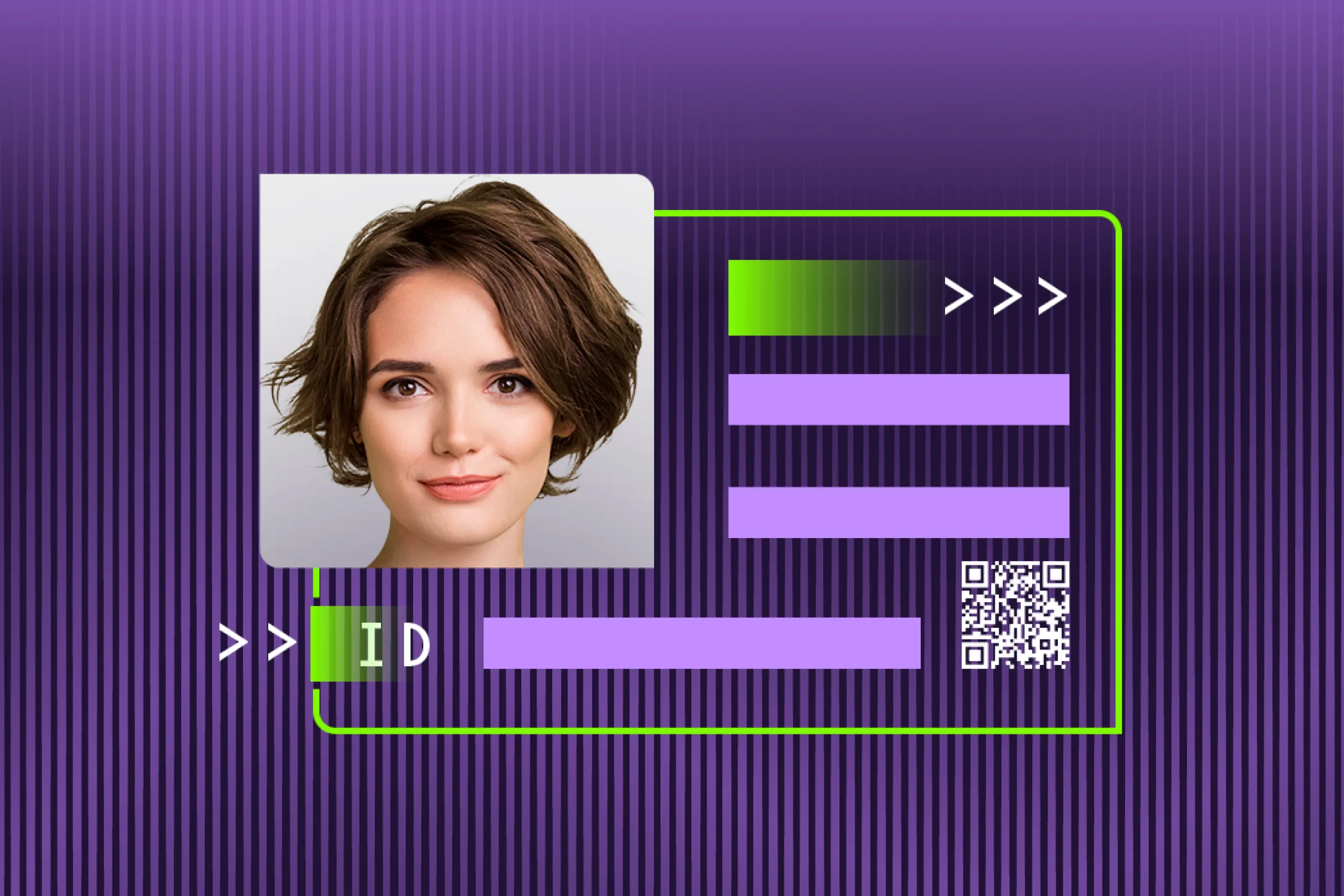What to expect in this blog
What does decentralized identity mean and how close are we to implementing it scale? This article explores the nature of decentralized identity, its components and potential use cases across finance, government, and education.
Identity verification and management is going through seismic changes with rapidly developing technology as a catalyst. For example, no sooner than face verification went mainstream, the industry had to adapt to the rising threat of deepfakes.
In a similar manner, as soon as the world realized that IDs could be stored digitally, some figured this concept could be taken a step further—to a fully decentralized identity.

In March 2025, the Web of Trust was unveiled as the world’s largest database of decentralized identity projects.
Decentralized identity uses cryptography and distributed systems (often blockchain technology) to give individuals total control over their digital ID, which is seen as a more tamper-resistant and privacy-preserving method. But how close are we to seeing it work at scale?
In this article, we delve into what decentralized identity is, how it works, and how it will likely find real-world applications in the coming years.
Subscribe to receive a bi-weekly blog digest from Regula
What is decentralized identity?
Decentralized identity is a modern approach to digital ID management where no single authority owns or controls the identity, apart from the user. This way, instead of having identifiers and credentials issued by central entities (e.g., governments, banks), individuals and organizations can create their own. In practice, this means users hold their identity data in a secure digital wallet and selectively share their information with third parties, rather than many organizations each storing full profiles on the user.
From a technical standpoint, decentralized identity is powered by decentralized identifiers (DIDs) and verifiable credentials (VCs), both standardized by the World Wide Web Consortium (W3C).
Explaining DIDs
A DID is a new type of unique identifier that is generated and owned by the user (or entity) and recorded on a decentralized network (like a blockchain or similar distributed ledger). If traditional identifiers are tied to a central registry or provider, DIDs are completely decoupled from them. In other words, a DID can be created without asking permission from some kind of authority, and it can be resolved (looked up) on a public ledger to retrieve its associated information.
Each DID has an associated DID Document that contains public keys and other metadata needed to prove control of the DID and to facilitate trustable interactions. The DID Document often includes one or more public keys (for example, in the form of cryptographic key pairs) that allow the identity owner to authenticate themselves.
Explaining VCs
VCs are digital, cryptographically signed statements about certain identity attributes or qualifications. They can represent any kind of identity information—for example, a credential could state a person’s age, citizenship, employment position, diploma, or any other claim. In essence, a verifiable credential is like a digital version of a plastic ID card or certificate, but with certain advantages: it can be instantly verified for authenticity, and it reveals no more information than necessary. This way, a VC might prove “Holder is over 18” without disclosing the holder’s full birth date or other personal data.
Decentralized identity vs. reusable identity
There is often confusion around decentralized identity and reusable identity, largely because both provide a single identity to be accepted by several different services.
In many cases, modern state-driven digital identity wallet programs combine elements of both (like the EUDI Wallet). That’s why these concepts are not necessarily to be contrasted; still, there are some technical differences.

How decentralized identity verification works
Decentralized identity introduces a new model for identity verification that doesn’t depend on a centralized database lookup or a single authority’s confirmation. Instead, it relies on a trust triangle of three roles—the issuer, the holder, and the verifier—and on cryptographic verification.
An important distinction
While it is true that decentralized digital identity on the whole is user-created and user-controlled, its VC component still needs to be issued by a reliable authority (e.g., a government). That is because VCs need to provide a trusted proof of specific identity-related claims, such as your citizenship, employment, or any other attributes. This proof could never be fully trusted if it weren’t validated by some kind of authority.
The crucial point is that once a VC is issued, the user controls it and manages it—just as it is the user who generates the DID and stores it in their own digital wallet.
.svg)
Issuer’s role
An issuer is a trusted entity that issues a VC to the user—this could be a government agency issuing a digital ID or a university issuing a diploma credential, among others.
The issuer creates a credential with claims about the subject (holder) and cryptographically signs it. The credential typically includes the issuer’s DID and a digital signature, often using the issuer’s private key corresponding to a public key in its DID Document. Once issued, the credential is given to the holder.
Holder’s role
A holder is an individual or organization that receives the credential and controls it.
The holder stores their credentials in a digital wallet, which can be an app on a smartphone or a secure cloud wallet. They have full control over their credentials—deciding when to present them, and to whom. Importantly, the holder can prove they are the rightful owner of a credential (for instance, by using their own keys if needed, or simply by possessing it if it’s bound to a DID they control).
Verifier’s role
A verifier is a party that needs to verify some aspect of the holder’s decentralized identity or claims; for example, a bank verifying a customer’s identity for onboarding.
The verifier will request the holder to present a credential or a subset of the data from it. The verifier then checks its authenticity by verifying the digital signature and checking that it was indeed issued by a trusted issuer, and hasn’t expired or been revoked. This verification is done by software, often leveraging the blockchain or registry where issuer DIDs and revocation registries are stored. Crucially, the verifier does not need to contact the issuer to verify the credential—they can trust the cryptographic proof.
Potential applications of decentralized identity
Decentralized digital identity opens up many potential use cases; in all of them, the common theme is improving security and efficiency, as well as empowering users. On top of that, without the need to repeatedly collect and store personal data, organizations can also reduce their liability and compliance costs.
Let’s take a closer look at some practical applications:
User onboarding in financial services
Banks and financial institutions spend significant time and money on Know Your Customer (KYC) checks and identity proofing when onboarding new customers. Typically, each bank does this separately, requiring customers to submit documents and wait for verification.
However, with decentralized digital identity, a customer could carry a KYC verifiable credential from a trusted identity verification provider or even from a government eID. When signing up for a new bank account, the customer would present that credential, and the bank would instantly verify it, checking the issuer's signature and validity.
This reduces onboarding time from days to minutes, improves the user experience, and could also open the door to new business models: for example, identity verification providers might issue reusable credentials for which they charge for each verification, essentially monetizing the KYC they performed once.
Government digital IDs and public services
Many governments are exploring digital identity wallets for their citizens—and some may go completely decentralized.
In this case, a government can serve as an issuer of official credentials, but once issued, the citizen controls where it’s used. With a digital ID wallet, a citizen could prove to a private company that they have a government-issued ID without the government being involved in that specific verification event.
Public services can also accept credentials issued by others: for instance, a welfare agency could accept a private bank’s KYC credentials as proof of identity to provide their services.
Education and professional credentials
Currently, verifying someone’s diploma or certificate often requires contacting the issuing institution or using background check services.
But by issuing diplomas as VCs, universities could have graduates hold a digital diploma that any employer can instantly verify cryptographically. The same goes for professional licenses issued to doctors, pilots, engineers, etc.—licensing bodies can issue digital licenses, and hospitals or clients can verify them on the spot. This also helps individuals in areas where credential verification can be difficult; for example, a refugee with digital credentials for their skills could prove them even if paper records are lost.
Digital identity wallets as DI enablers
Note: Digital identity wallets are a developing technology and, as of May 2025, the vast majority of them are at either the concept stage or the pilot stage.
Digital identity wallets are software applications that store and manage DIDs and VCs on behalf of users, functioning like a personal vault for digital identity data. Typically, the wallet generates a private key (or keys) for the user’s decentralized identity and protects it with device security or encryption. Some wallets also use hardware security modules or secure enclaves to prevent key theft, and may use device binding plus cryptographic attestation to ensure the wallet instance hasn’t been tampered with.
The aforementioned selective disclosure mechanism is one of the wallets’ key features, as it allows wallets to reveal only necessary information from a credential rather than the entire data set. For that purpose, wallets implement cryptographic techniques such as zero-knowledge proofs or selective disclosure signatures (e.g., BBS+ or the IETF SD-JWT standard).
Safeguarding the safe
Since a digital wallet essentially becomes one’s fully functional ID, it must be ensured that only the holder has access to the wallet. That’s why some wallets integrate biometrics for security—the user can only unlock the wallet via fingerprint or face scan. Other biometric checks, like a selfie comparison to a photo ID, may also be required during credential issuance or presentation.
Some systems also handle biometric identity data within credentials (e.g., storing a facial image or fingerprint as part of a digital ID), but they do so in privacy-preserving ways.
From the user’s perspective, the wallet must put them in control and be highly usable. Good wallets feature simple UX (e.g., scanning a QR code and tapping to consent) rather than complex key management. They provide clear, human-readable prompts about what data is being shared, so users can make informed decisions and give consent for each credential presentation.
Example: In 2024, the European Union formally adopted a framework for the European Digital Identity Wallet (EUDI Wallet) under the revised eIDAS regulation. This requires every member state to offer a digital identity wallet by 2026 and to recognize wallets from other EU countries. The EUDI Wallet will allow citizens to link their national digital IDs with other personal credentials (e.g., a driver’s license) and use them without having to rely on private identity providers or share unnecessary data.
As for the global scale, recent analyses confirm that decentralized identity is gaining attention almost everywhere. Roughly 60% of countries working on digital ID are also exploring decentralized ID in some form (usually blending it with traditional systems). Looking forward, market forecasts are optimistic. Analysts project that the digital identity market will reach $200+ billion by 2034, and by 2035, about 25–35% of digital IDs will be decentralized in some way.
How Regula’s solutions complement decentralized identity
Decentralized identity is redefining how identity verification is handled, but it isn’t about discarding traditional methods outright; rather, it builds on them. Decentralized identity verification still requires initial proofing of identities to issue trusted credentials—and this is where Regula’s technology steps in.
Complete identity verification procedures can be carried out by solutions like Regula Document Reader SDK and Regula Face SDK, which can easily integrate with your existing mobile or web applications.
Regula Document Reader SDK processes images of documents and verifies their real presence (liveness). The software automatically identifies the document type, extracts all the necessary information, cross-validates it and confirms whether the document is genuine with the comprehensive set of authenticity checks. Regula Document Reader SDK supports all major dynamic security features including holograms, optically variable inks (OVI), multiple laser images (MLI), and, most recently, Dynaprint®.
At the same time, Regula Face SDK conducts instant facial recognition and prevents fraudulent presentation attacks such as the use of static face images, printed photos, video replays, video injections, or masks.
In practical terms, Regula’s software could be integrated as the front-end in an issuer’s process within decentralized identity systems. Eager to learn more? Book a call, and we will help you make your identity verification compliant, secure, and customer-centric.





